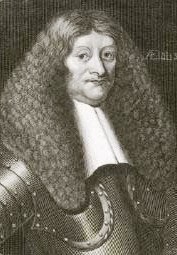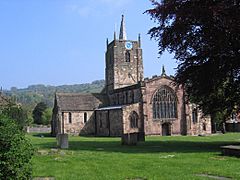Sir John Gell, 1st Baronet facts for kids
Quick facts for kids
Sir John Gell
|
|
|---|---|

Sir John Gell
|
|
| Parliamentarian Commander Derbyshire, Staffordshire, and Warwickshire, Governor of Derby | |
| In office 1643–1646 |
|
| Deputy Lieutenant of Derbyshire | |
| In office August 1642 – July 1646 |
|
| High Sheriff of Derbyshire | |
| In office 1635–1636 |
|
| Personal details | |
| Born | 22 June 1593 Hopton, Derbyshire, England |
| Died | 26 October 1671 (aged 78) Westminster, London, England |
| Resting place | St Mary's Church, Wirksworth |
| Spouses | (1) Elizabeth Willoughby (1610–1644) (2) Mary Stanhope (1647–1648; dissolved) |
| Children | (1) Mary and Elizabeth |
| Alma mater | Magdalen College, Oxford |
| Occupation | Landowner, soldier and administrator |
| Military service | |
| Years of service | 1642 to 1648 |
| Rank | Colonel |
| Battles/wars |
|
Sir John Gell (born June 22, 1593 – died October 26, 1671) was an important English landowner from Derbyshire. He became a key commander for the Parliament's army, known as the Roundheads, during most of the First English Civil War. He was famous for how he handled the body of a Royalist opponent after the Battle of Hopton Heath in March 1643.
People said Gell was the richest man in Derbyshire. He was a strong and active leader. However, his soldiers often didn't get paid. This led to many complaints about them taking things from people. One writer, Lucy Hutchinson, said Gell didn't truly understand the war's reasons. She also said his soldiers were very difficult to control.
Gell stopped being a commander just before the First Civil War ended in 1646. His actions during the Second English Civil War were unclear. Because of this, he lost all his official jobs in February 1649. In 1650, he was linked to a Royalist plan. He was sent to prison for life but was let go three years later due to poor health. After the king returned in 1660, he was officially forgiven. He lived quietly in London and passed away in October 1671.
Contents
Sir John Gell's Early Life and Family

John Gell was born on June 22, 1593, in Hopton, Derbyshire. His parents were Thomas Gell and Millicent Sacheverell. His father died soon after his younger brother Thomas was born in 1594. His mother then married John Curzon. John Gell lived with them at Kedleston Hall until 1614. He became very close to his half-brother, Sir John Curzon, 1st Baronet.
In January 1609, John Gell married Elizabeth Willoughby. They had six children who grew up: Millicent, Bridgett, John, William, Elizabeth, and Eleanor.
In 1648, he married Mary Stanhope. She was the widow of Sir John Stanhope. This marriage surprised many people. Mary's family was a leading Royalist family in Derbyshire. John Gell had been in a long-running disagreement with her first husband and then with her brother-in-law. This marriage lasted less than a year.
Before the English Civil War
John Gell finished his studies at Magdalen College, Oxford in 1610. He then lived in Kedleston before moving to Hopton around 1620. He was one of the wealthiest men in Derbyshire. His money came mostly from sheep farming and from the lead mining industry. He earned money from lead mines near Bakewell, Hope, and Tideswell. He was known for being argumentative. This led to many legal fights over money owed to him. These disputes made him unpopular in the area.
Gell did not support King Charles I. For example, he only gave a small amount of money to a special loan in 1625. He also refused to help pay for the local army in 1630. During the time when King Charles I ruled without Parliament (1629-1640), the king often put his opponents in charge of collecting taxes. This made them responsible for the full amount. In 1632, Gell and his brother Thomas were put in charge of collecting payments for the Duchy of Lancaster's lands in Derbyshire and Staffordshire. Gell also became the High Sheriff of Derbyshire in 1635. In this role, he had to collect a very unpopular tax called Ship Money.
The Gell brothers took property from people who didn't pay their taxes. This caused a lot of anger locally. One person affected was Sir John Stanhope. When he died in 1638, his wife Mary and cousin Philip Stanhope took their case to the king's advisors. They lost, but the disagreement continued into the Civil War. As war was coming, King Charles I tried to raise money by selling special titles. In January 1642, John Gell bought a baronetcy title for £300.
Fighting in the English Civil War (1642–1646)
As a Presbyterian, Gell generally supported Parliament. However, the lead mines in Derbyshire were important for making ammunition. Because of this, King Charles tried to get Gell's support, but he failed. When the war started in August 1642, Gell was told to secure Derbyshire for Parliament. He formed a regiment, and his brother Thomas became a high-ranking officer. The local Royalist leader was Chesterfield. When Chesterfield attacked Hopton Hall, Gell fought back by attacking Chesterfield's home, Bretby Hall. He then attacked Elvaston Castle, which used to belong to Sir John Stanhope. It was said he damaged Stanhope's tomb and dug up his flower beds.
In March 1643, Gell joined Lord Brooke in an attack on Lichfield Cathedral. Royalist soldiers, led by Chesterfield, were holding the cathedral. After Lord Brooke was killed, Gell took command. He captured the cathedral and Chesterfield, who was then held in London. Gell then joined Sir William Brereton in an attack on Stafford. This led to the Battle of Hopton Heath on March 19. Parliament's cannons were captured, but the Royalist commander, the Earl of Northampton, was killed. Gell offered to return Northampton's body for his cannons. When this was refused, he had Northampton's body shown through the streets of Derby before it was buried.
The Royalists soon took back Lichfield. However, Gell replaced Lord Brooke as Parliament's commander in Staffordshire and Warwickshire. He was also made Governor of Derby in 1644. Gell was an active and skilled soldier. But he often bullied the Derbyshire county committee. His soldiers were not paid, and they became known for taking things from people. This led to many complaints to Parliament. In April 1645, the New Model Army was formed, which reduced Gell's power. He was unhappy that Derbyshire was used as a base for their troops. He reportedly ignored orders to bring his troops to the Battle of Naseby in June. He was then criticized for letting 3,000 Royalist cavalry escape him at Ashbourne.
As the war was ending in April 1646, it was found that Gell was making a deal with the Royalist soldiers at Tutbury Castle. His terms were better than those offered by his colleague, Sir William Brereton. Gell then resigned from his command. He went to London to ask for money he said he was owed. To be safe, he first gave his properties to his son John, keeping a yearly payment of £1,100 for himself.
Sir John Gell After the War
In 1645, Thomas Gell became a Member of Parliament for Derby. He helped his brother get £1,200 from Parliament in October 1647 for money he was owed. After the war, there was a struggle over how the country should be governed. Gell sided with the moderate Parliamentarians against the New Model Army. Earlier, in 1643, King Charles had offered a general pardon to his opponents, but Gell was the only person in Derbyshire not included. Now, Gell had to pay the king £900 to receive a pardon.
Gell's hopes of getting his power back ended when the Royalists lost the Second English Civil War. King Charles I was executed in January 1649. Thomas Gell was removed from Parliament in December 1648. Sir John Gell himself lost all his official jobs in February 1649. During the time when England had no king (1650), Gell was involved in a plan to bring back Charles II. This plan was led by a Royalist lawyer named Eusebius Andrews. Gell was careful not to fully commit himself. However, one of his servants was later executed. Gell was found guilty of not telling authorities about the plan. He had transferred his properties in 1646, so they could not be taken from him. But he was sentenced to life in the Tower of London. In 1653, he was released due to poor health and allowed to live in a private house in London.
After the king returned in May 1660, Gell was officially pardoned. He was given a small job in the Royal Household. He lived in London and died on October 26, 1671. He was buried in St Mary's Church, Wirksworth.
Images for kids
| Baronetage of England | ||
|---|---|---|
| New creation | Baronet (of Hopton) 1642–1671 |
Succeeded by John Gell |



